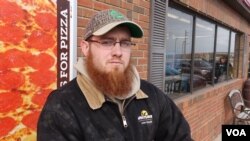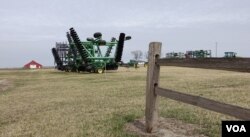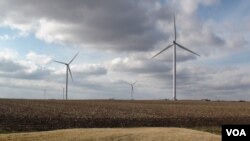Twenty-five-year-old Dustin Andrews came by Casey’s General Store, a convenience store and gas station near the entrance to Donnellson, Iowa, for some cookies and other snacks.
“I only live about five miles [eight kilometers] away, so it’s easy to drop by and pick up a few things,” he said.
Donnellson, like many small towns in the farm belt, has few stores in its downtown, and after dark or on weekends, most are closed. The convenience store on the edge of town is an exception.
Small towns in rural areas once thrived on business from farmers and others involved in agriculture, but there are fewer farmers now, and improved roads allow people to travel farther away to larger stores, like Wal-Mart, that offer more variety and better prices.
Andrews works full time at the Siemens factory in Fort Madison, but lives out in the countryside because he likes it there.
“I would quit what I do and farm if I could,” he told VOA.
When he graduated from high school, he faced a situation all too common for young people who grow up on farms: There is only so much land, and with highly mechanized operations, demand for labor is low.
Manufacturing jobs
The Siemens plant, which makes the 2-ton blades for the giant wind generators found in Iowa and other rural parts of the American heartland, employs about 700 people, paying them more than $20 an hour. Andrews started there right out of high school, but he never completely stopped being a farmer, working for free to help out his farmer cousin, and renting land near Fort Madison, where he keeps 20 head of Angus and Hereford cows, along with one bull for breeding.
“I let them calve and raise them until they are 800 pounds [360 kilograms] and sell them, keeping some back for replacements,” he said. “I learned about breeding cows from my grandpa on my father’s side, who had Angus cows.”
He and many other young people oriented toward farming have had to dampen their aspirations. The economics are against them, with land prices high and all other aspects of modern farming expensive as well.
The U.S. Department of Agriculture’s 2012 census shows that the average principal operator of a farm in the United States is now a 58-year-old male. Between 1997 and 2012 there was a nearly 20 percent drop in the number of new farmers. The census shows that the number of farms decreased more than 4 percent, to just above 2.1 million, while the size of the average farm increased by 3.8 percent, to 434 acres (175 hectares).
Andrews’ main reason for being in Donnellson on this day was to take an open-carry class, required by the state for anyone who transports a firearm that is not enclosed in a case. In many urban areas, people have taken such classes in order to get a permit to carry a pistol on a belt, but Andrews said he had no interest in that. He is an avid hunter who wants the convenience of being able to have his rifle or shotgun in his truck, ready for use during hunting season. He hunts deer, duck and turkey.
No taste for politics
One thing Andrews and many young people like him in this area do not enjoy is politics. He has been eligible to vote for seven years and could have voted in both the 2012 and 2016 presidential elections, but he stayed away from the polls for both of those. He said there are no issues he is concerned with, save one.
“I hope the wind energy business keeps going,” he said, President Donald Trump "is not a big fan of it.”
Andrews, whose job it is to check turbine blades for flaws and then repair them, benefits personally from the wind energy industry, but has little to say about the environmental benefits many people associate with renewable energy.
Iowa is one of the nation’s top wind-power states, generating nearly a third of the electricity it uses with wind turbines. But even though he fears the Trump administration’s emphasis on traditional fossil fuel development could affect his industry and perhaps his job, Andrews doesn’t seem to think there is much he could do about it.









